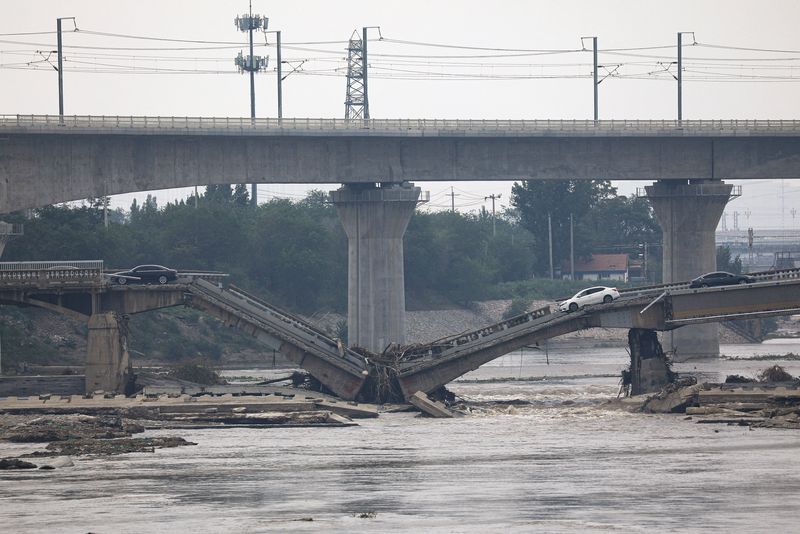By Liz Lee, Ryan Woo and Ethan Wang
BEIJING (Reuters) -From coping with dangerously swollen rivers to helping residents trapped in waterlogged cities, China's disaster-response systems are being put to the test after one of the strongest storms in years brought record rainfall that could take weeks to recede.
Typhoon Doksuri battered northern China this week with extreme rain, breaking Beijing's 140-year rainfall record and dumping volumes of rain that normally fall in a whole year in the populous province of Hebei.
As the last of Doksuri's rain drift into China's northeastern border provinces, a region the size of Britain is grappling with the aftermath and the urgent tasks of safely discharging overflowing water from reservoirs and rescuing tens of thousands of people trapped in their homes.
As of Thursday, more than 1.2 million people in Hebei had been taken to safety. The volume of rain that fell in the province exceeded the storage capacity of its large and medium-sized reservoirs by more than two-fold, state media said.
The Hai river basin, where five rivers converge and which includes Hebei and Beijing, is going through a "flood evolution process" with its flood-control engineering systems experiencing the "most severe test" since inundations in 1996, state media reported.
In the summer of 1996, large-scale flooding in the Yangtze river basin killed about 2,800 people, damaged millions of homes and inundated swathes of cropland.
Authorities in Hebei raised its natural disaster emergency response level while Beijing kept a warning in place for landslides on its outskirts.
Floodwaters could take up to a month to recede in Hebei, where Zhuozhou is the hardest hit city, a water resources department official told state media. About 100,000 people in the city southwest of Beijing have been evacuated, or a sixth of its population.
China has long been aware of urban waterlogging risks, with rapid urbanisation creating metropolitan sprawls that cover floodplains with concrete. Extreme weather driven by global warming is making it worse.
Rainfall in northeastern provinces could be as much as 50% higher than normal in August, China's national forecaster warned.
LOGISTICS NIGHTMARE
One severely affected area in Zhuozhou is the township of Matou, where roads turned into rivers, power and drinking water supplies have been cut, mobile phone signals are down and many residents are trapped in their homes.
Rescuers in rubber rafts and boats plied Matou's waterlogged streets, stopping to belay trapped residents down from high-rise buildings. Some residents were carried to safety by large forklifts, a state broadcaster reported.
"Is there no way to discharge the water now? The water is not receding and the rescue efficiency is too low," said one social media user, alarmed that some places in Zhuozhou are 6 metres (20 feet) under water.
"The six metres of water is not a problem of heavy rains at all, but a problem of flood discharge."
But rescue efforts have been difficult.

City and emergency management officials have stopped accepting new rescue teams from elsewhere, state-backed media reported, citing over-crowded access routes and a lack of coordination as adding to safety concerns.
State media said rescuers from around China have been offering to help with Zhuozhou's flood relief but some have not received the approval they need from officials to operate on the ground.
